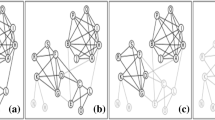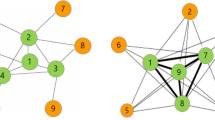Abstract
In the traditional network structure analysis research, it mainly analyzes the characteristics of individuals in the network or the way of connection. However, these studies do not reflect the general phenomenon of social networks, for example, each organization usually includes individuals with different characteristics. Only by fully understanding the characteristics and the original hierarchical structure of the network, can we improve the network security and the management of the network. Therefore, we aim to analyze the overall characteristics of the network and dissect the relationship between the layers of various networks as well as the relationship between individuals in each layer without destroying the network structure. From a new point of view, the network is analyzed by using the characteristics of network matrix structure and some properties of core/periphery structure. We analyze several real networks and verifies the intensity of the core/periphery structure relationship in the network.
Access this chapter
Tax calculation will be finalised at checkout
Purchases are for personal use only
Similar content being viewed by others
References
Albert, R., Barabási, A.L.: Statistical mechanics of complex networks. Rev. Mod. Phys. 74(1), 47 (2002)
Boccaletti, S., Latora, V., Moreno, Y., Chavez, M., Hwang, D.U.: Complex networks: structure and dynamics. Phys. Rep. 424(4–5), 175–308 (2006)
Borgatti, S.P., Everett, M.G.: Models of core/periphery structures. Soc. Netw. 21(4), 375–395 (2000)
Clauset, A., Moore, C., Newman, M.E.: Hierarchical structure and the prediction of missing links in networks. Nature 453(7191), 98–101 (2008)
Diani, M., Wasserman, S., Faust, K.: Social Network Analysis: Methods And Applications, p. 825. Cambridge, Cambridge University Press (1994). Italian Political Science Review/Rivista Italiana di Scienza Politica 25(3), 582–584 (1995)
Fortunato, S.: Community detection in graphs. Phys. Rep. 486(3–5), 75–174 (2010)
Goyal, S.: Connections: An Introduction to the Economics of Networks. Princeton University Press, Princeton (2012)
Haggerty, K.L., Griffith, J., McGuire, J., Molnar, B.: Elder mistreatment and social network composition: an exploratory study. Soc. Netw. 59, 23–30 (2019)
Ingram, D.A., et al.: Identification of a novel hierarchy of endothelial progenitor cells using human peripheral and umbilical cord blood. Blood 104(9), 2752–2760 (2004)
Kovács, I.A., Palotai, R., Szalay, M.S., Csermely, P.: Community landscapes: an integrative approach to determine overlapping network module hierarchy, identify key nodes and predict network dynamics. PloS One 5(9), e12528 (2010)
Krogan, N.J., et al.: Global landscape of protein complexes in the yeast saccharomyces cerevisiae. Nature 440(7084), 637–643 (2006)
Lahav, N., Ksherim, B., Ben-Simon, E., Maron-Katz, A., Cohen, R., Havlin, S.: K-shell decomposition reveals hierarchical cortical organization of the human brain. New J. Phys. 18(8), 083013 (2016)
Lewis, T.G.: Network Science: Theory and Applications. Wiley, Hoboken (2011)
Moskvina, A., Liu, J.: How to build your network? A structural analysis. arXiv preprint arXiv:1605.03644 (2016)
Newman, M.E.: The structure and function of complex networks. SIAM Rev. 45(2), 167–256 (2003)
Newman, M.E.: Complex systems: A survey. arXiv preprint arXiv:1112.1440 (2011)
Rombach, M.P., Porter, M.A., Fowler, J.H., Mucha, P.J.: Core-periphery structure in networks. SIAM J. Appl. Math. 74(1), 167–190 (2014)
Saavedra, S., Malmgren, R.D., Switanek, N., Uzzi, B.: Foraging under conditions of short-term exploitative competition: the case of stock traders. Proc. R. Soc. B: Biol. Sci. 280(1755), 20122901 (2013)
Schneider, C.M., Moreira, A.A., Andrade, J.S., Havlin, S., Herrmann, H.J.: Mitigation of malicious attacks on networks. Proc. Natl. Acad. Sci. 108(10), 3838–3841 (2011)
Smilkov, D., Kocarev, L.: Rich-club and page-club coefficients for directed graphs. Phys. A 389(11), 2290–2299 (2010)
Stanley, N., Shai, S., Taylor, D., Mucha, P.J.: Clustering network layers with the strata multilayer stochastic block model. IEEE Trans. Netw. Sci. Eng. 3(2), 95–105 (2016)
Yan, B., Liu, Y., Liu, J., Cai, Y., Su, H., Zheng, H.: From the periphery to the center: information brokerage in an evolving network. arXiv preprint arXiv:1805.00751 (2018)
Zhang, F., Li, C., Zhang, Y., Qin, L., Zhang, W.: Finding critical users in social communities: the collapsed core and truss problems. IEEE Trans. Knowl. Data Eng. 32(1), 78–91 (2018)
Zhang, F., Zhang, Y., Qin, L., Zhang, W., Lin, X.: Finding critical users for social network engagement: the collapsed k-core problem. In: Proceedings of the Thirty-First AAAI Conference on Artificial Intelligence, pp. 245–251 (2017)
Author information
Authors and Affiliations
Corresponding author
Editor information
Editors and Affiliations
Rights and permissions
Copyright information
© 2021 Springer Nature Singapore Pte Ltd.
About this paper
Cite this paper
Luo, C., Chen, C., Chen, W. (2021). Anatomy of Networks Through Matrix Characteristics of Core/Periphery. In: Sun, Y., Liu, D., Liao, H., Fan, H., Gao, L. (eds) Computer Supported Cooperative Work and Social Computing. ChineseCSCW 2020. Communications in Computer and Information Science, vol 1330. Springer, Singapore. https://doi.org/10.1007/978-981-16-2540-4_37
Download citation
DOI: https://doi.org/10.1007/978-981-16-2540-4_37
Published:
Publisher Name: Springer, Singapore
Print ISBN: 978-981-16-2539-8
Online ISBN: 978-981-16-2540-4
eBook Packages: Computer ScienceComputer Science (R0)





